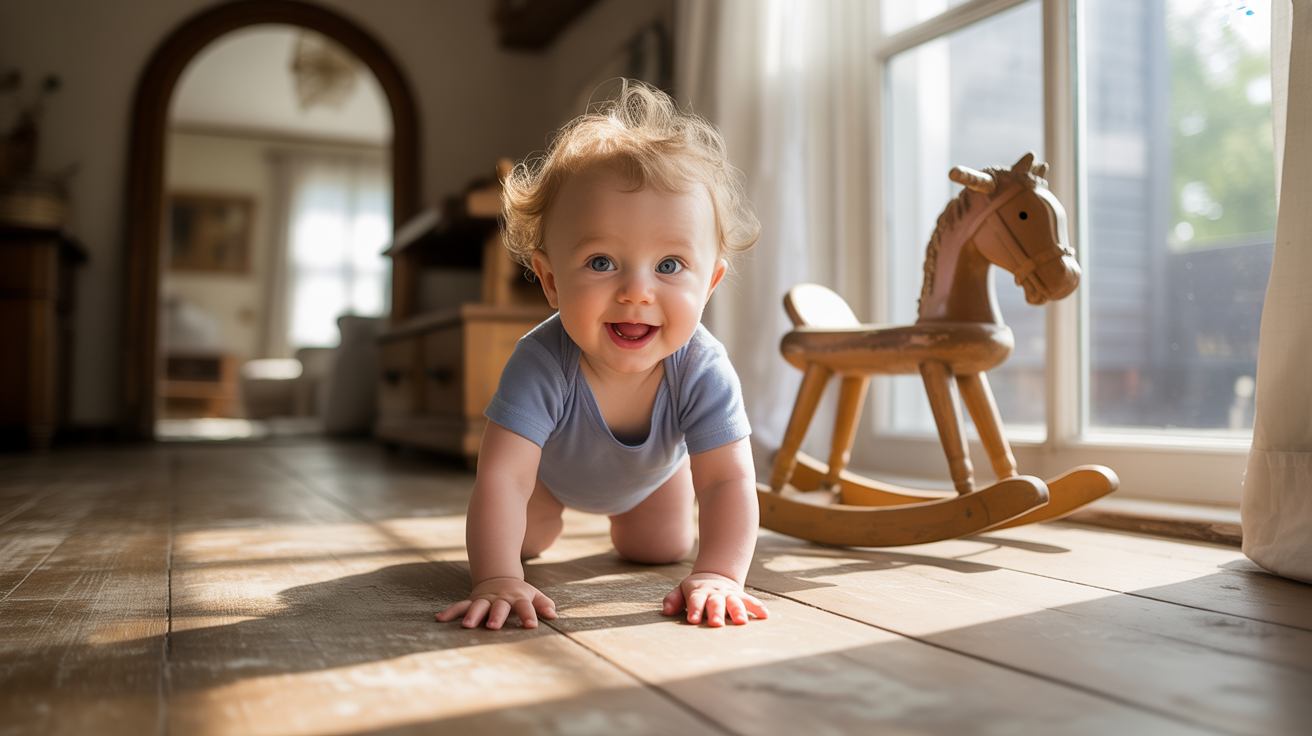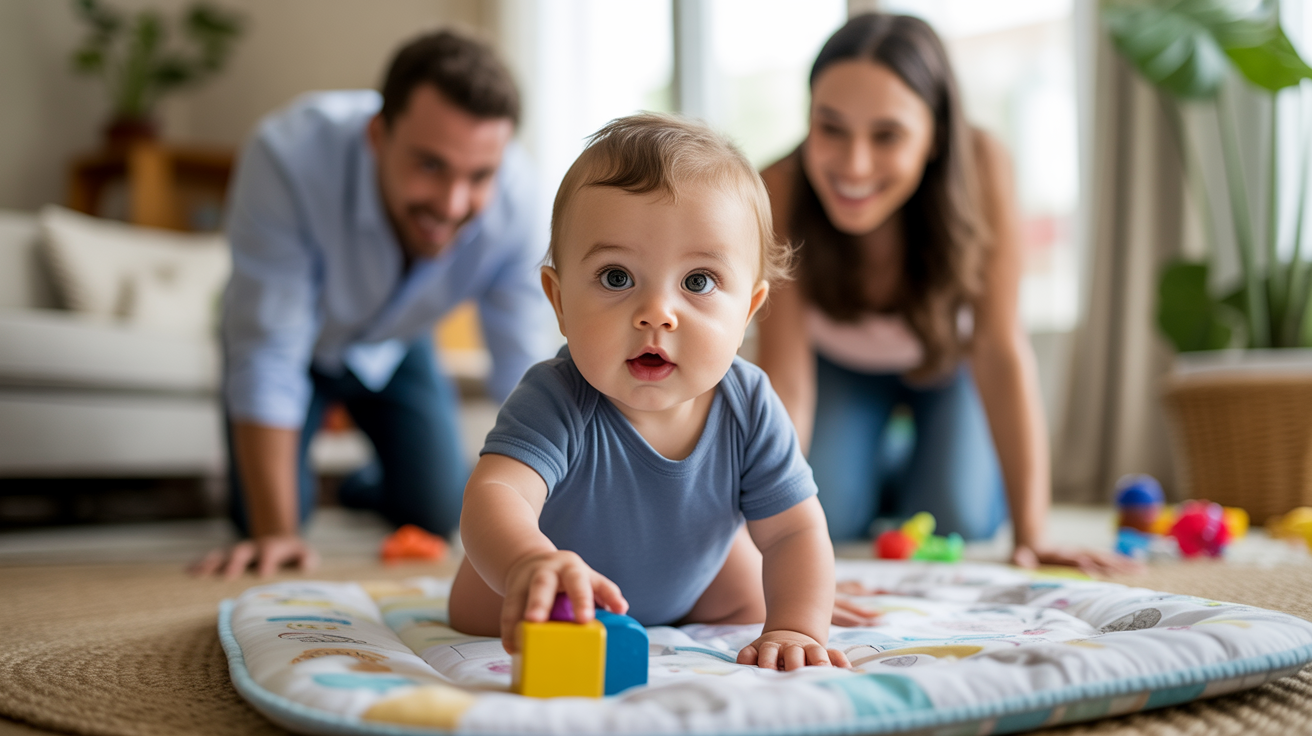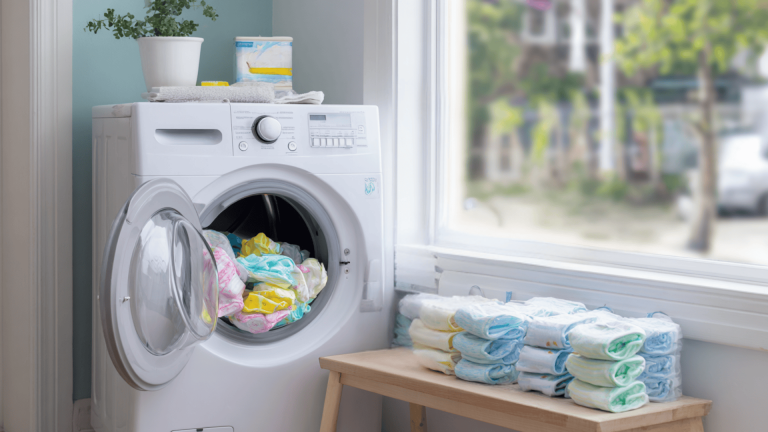Why Your 11 Month Old Isn’t Crawling & How to Help?

Why isn’t my 11-month-old crawling yet – should I be worried?
If you’re watching other babies zoom around like tiny race cars while your little one seems perfectly content being a professional sitter, take a deep breath!
Every baby writes their own developmental story, and some prefer to perfect their sitting skills, master babbling, or even surprise everyone by skipping crawling entirely and going straight to walking.
This concern is incredibly common among parents, but here’s the reassuring truth: babies develop at wonderfully different paces.
This guide will look into the various reasons why your baby might be taking their sweet time with crawling and offer practical, gentle strategies to support their unique journey to mobility.
What is Crawling?
It’s not just the classic hands-and-knees move you might picture! Babies are wonderfully creative movers.
Some prefer the “army crawl” belly-slide across the floor, others become expert bottom-scooters, and some do an adorable bear walk on hands and feet.
Each unique style builds crucial core muscles, hand-eye coordination, and spatial awareness.
So if your baby rolls, scoots, or shimmies forward, they’re developing important motor skills that prepare them for walking!
Remember, there’s no “right” way to crawl – every baby finds their own perfect method. Trust your little one’s natural instincts and celebrate their unique journey toward mobility!
When Should I Expect My Baby to Start Crawling?
Most babies begin crawling between 6 to 10 months, but don’t panic if yours hasn’t started yet. Some babies actually skip crawling completely and go straight to walking!
The timing depends on several factors: your baby’s temperament (cautious vs. adventurous), their physical development and muscle strength, and their environment.
Every baby follows their own timeline, so focus on their overall progress rather than hitting specific milestones on schedule.
If you have concerns about your baby’s development, don’t hesitate to discuss them with your pediatrician. What matters most is that your little one is exploring their world and building confidence in their own special way!
Why is Crawling Important?
Crawling isn’t just adorable – it’s like a full-body workout and brain training session rolled into one!
- Muscle Development: Crawling is like baby boot camp! It strengthens core muscles, arms, and legs while building the foundation your little one needs for standing and walking confidently.
- Coordination: This cross-pattern movement teaches both sides of the brain to work together, improving hand-eye coordination and setting the stage for future skills like writing and sports.
- Cognitive Benefits: As babies navigate around furniture and through spaces, they’re developing spatial awareness, problem-solving skills, and learning cause-and-effect relationships with their environment.
- Investigation: Crawling unlocks a whole new world! Babies gain independence, satisfy their natural curiosity, and build confidence as they recognise they can move toward interesting objects and people.
When your baby gets moving on hands and knees, they’re building the foundation for virtually every physical skill they’ll need later.
What Is Delayed Crawling and Is It Normal?
Want to know more? Check out this super informative video by: @FirstCryParenting
Delayed crawling means your baby hasn’t started crawling by 10-12 months, when most babies have already mastered this skill.
Here’s the reassuring truth: it’s often completely normal! Every baby develops on their own timeline, and some are simply late bloomers who prefer perfecting other skills first.
Some babies skip crawling entirely and go straight to pulling up, cruising, or even walking.
Others might use alternative methods like bottom-scooting or rolling to get around, which shows they’re still developing important motor skills and problem-solving abilities.
Delayed crawling becomes a concern if your baby shows no interest in moving by 15 months, isn’t reaching other milestones like sitting independently or showing curiosity about their environment, or if you notice muscle weakness or other physical limitations.
In most cases though, your little one is just following their unique developmental path – and that’s perfectly okay!
7 Reasons Why an 11-Month-Old Might Not Be Crawling
From late bloomers to bottom-scooters, learn why some babies take the scenic route to mobility and when to worry.

1. Normal Developmental Variation
Just like adults have different strengths and timelines, babies develop at their own pace. Some focus intensely on perfecting sitting or standing skills before moving on to crawling.
If your baby is meeting other milestones like sitting independently, babbling, and showing curiosity about their surroundings, they’re likely just following their personal development schedule.
2. Premature Birth
Instead of using their actual age, focus on their “corrected age” (calculated from their due date).
A baby born two months early might crawl closer to 13 months actual age, which equals 11 months corrected age.
Their little bodies are working hard to develop skills that full-term babies had more time to prepare for in the womb.
3. Insufficient Tummy Time
Tummy time is like the gym for babies – without enough practice, those crucial neck, shoulder, and core muscles don’t get strong enough for crawling!
If your baby hasn’t had regular tummy time sessions, they might lack the upper body strength needed to support themselves on hands and knees.
The good news? It’s never too late to start building these essential muscles through supervised floor play and tummy time activities.
4. Preference for Scooting or Rolling
Why crawl when you can roll like a little log or scoot around on your bottom?
Some babies learn these alternative movement methods and think, “This works perfectly!” Bottom-scooting is especially common and efficient – babies can sit upright, see everything around them, and still get where they want to go.
These clever little problem-solvers have found their own solution to mobility and may skip traditional crawling entirely.
5. Physical or Muscular Limitations
Sometimes babies face physical challenges that make crawling more difficult, such as low muscle tone (hypotonia), joint stiffness, or muscle weakness.
These issues don’t mean your baby won’t eventually move – they might just need extra support and possibly physical therapy to strengthen specific muscle groups.
Early intervention can make a huge difference, so if you notice persistent physical challenges, consult your pediatrician for guidance and potential referrals.
6. Environmental Constraints
Your home setup might inadvertently discourage crawling!
Babies who spend lots of time in bouncy seats, walkers, or being carried may have fewer opportunities to practice floor skills.
Hard floors, limited safe crawling space, or overly clean environments (where babies aren’t allowed to play freely) can also delay crawling.
7. Medical Conditions (Rare Cases)
In uncommon situations, underlying medical conditions like developmental delays, neurological issues, or genetic conditions might affect motor development.
These cases typically involve other concerning signs beyond just delayed crawling, such as poor muscle tone, feeding difficulties, or significant delays in multiple developmental areas.
If you notice several red flags together, your pediatrician can evaluate whether further investigation or specialist referrals are needed.
Tips for Encouraging Your 11-Month-Old to Crawl

Help your little one become a crawling champion with these fun, proven strategies that make movement irresistible! These simple techniques will change your couch potato into an active explorer.
- Increase Tummy Time – Begin with short, frequent sessions and gradually increase the duration using colorful toys and mirrors.
- Use Toys as Motivation – Place favorite toys just out of reach to encourage forward movement and crawling effort.
- Create a Safe Practice Space – Clear a large floor area with soft rugs so babies can practice confidently.
- Demonstrate Crawling Yourself – Get down on all fours and show your baby how crawling works through play.
- Prioritize Floor Play Time – Make the floor the most interesting place by rotating toys and creating obstacle courses.
Remember, every baby develops at their own pace, so stay patient and celebrate small victories! With consistent practice and encouragement, your little one will be crawling before you know it.
When to Seek Pediatric Advice?
Trust your parental instincts – they’re usually spot-on!
Schedule a pediatric consultation if your baby shows no interest in any form of movement by 12-15 months, has lost previously acquired skills, or displays concerning signs like persistent poor muscle tone, feeding difficulties, or significant delays across multiple developmental areas.
Additionally, seek advice if your baby seems unusually stiff, floppy, or shows no curiosity about their surroundings.
While most crawling delays are completely harmless and resolve naturally, early intervention services can provide valuable support when truly needed, giving your little one the best foundation for future development.
Conclusion
Remember, your baby’s trip to mobility is beautifully unique – if they’re traditional crawlers, creative bottom-scooters, or surprise walkers!
While most babies crawl between 6 and 10 months, delays are often simply a matter of individual timing rather than developmental concerns.
Focus on creating encouraging environments with plenty of tummy time, floor play, and enticing toys just out of reach.
Trust your baby’s personal timeline while staying alert to their overall progress and curiosity about the world.
If concerns arise or multiple milestones seem delayed, don’t hesitate to consult your pediatrician. Every movement milestone your little one reaches is worth celebrating, whenever it happens!






